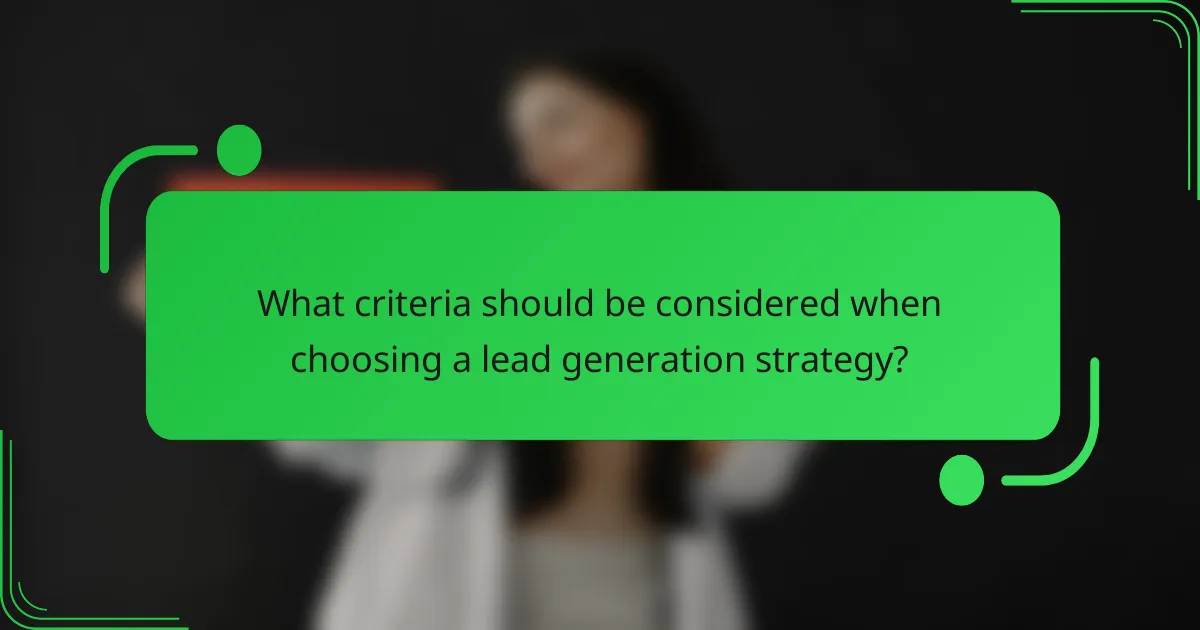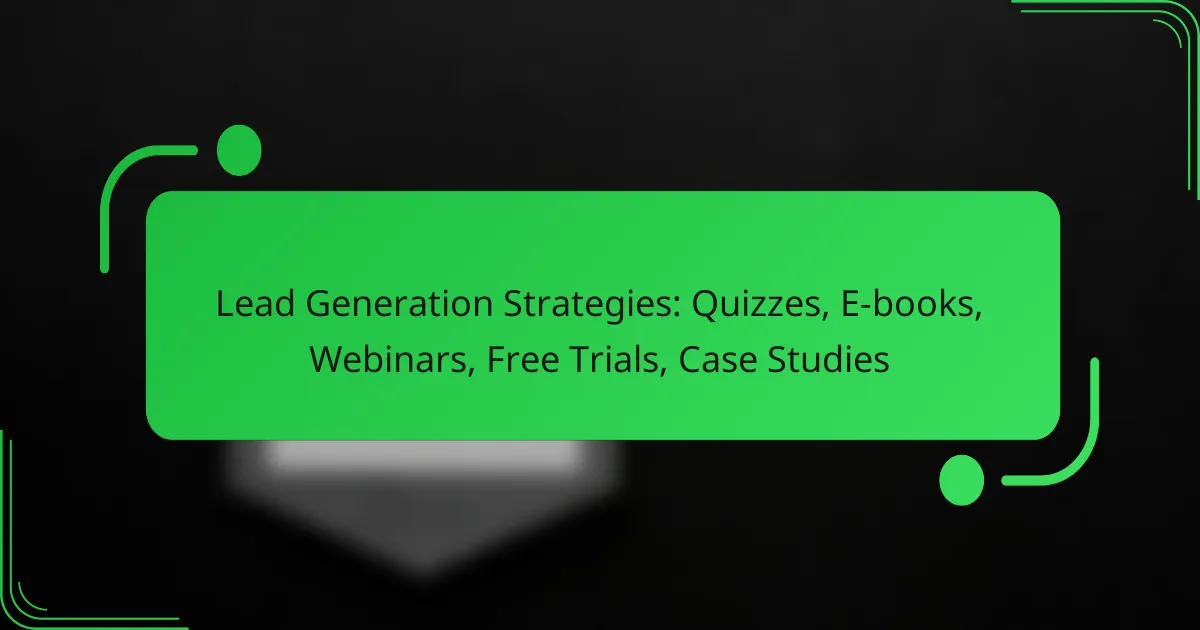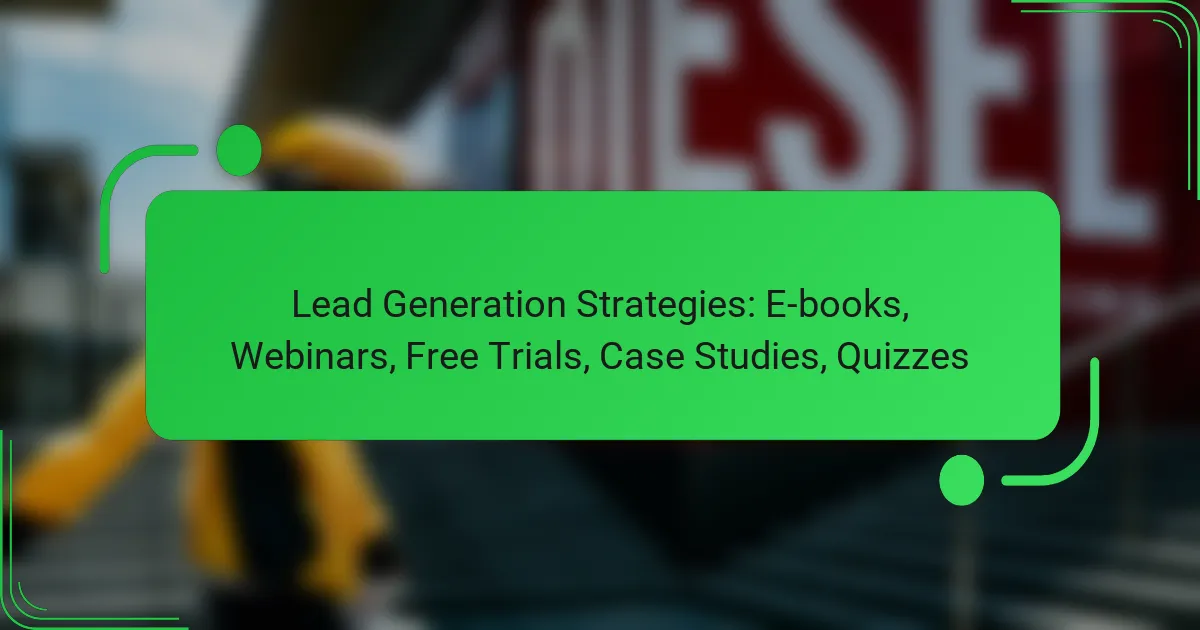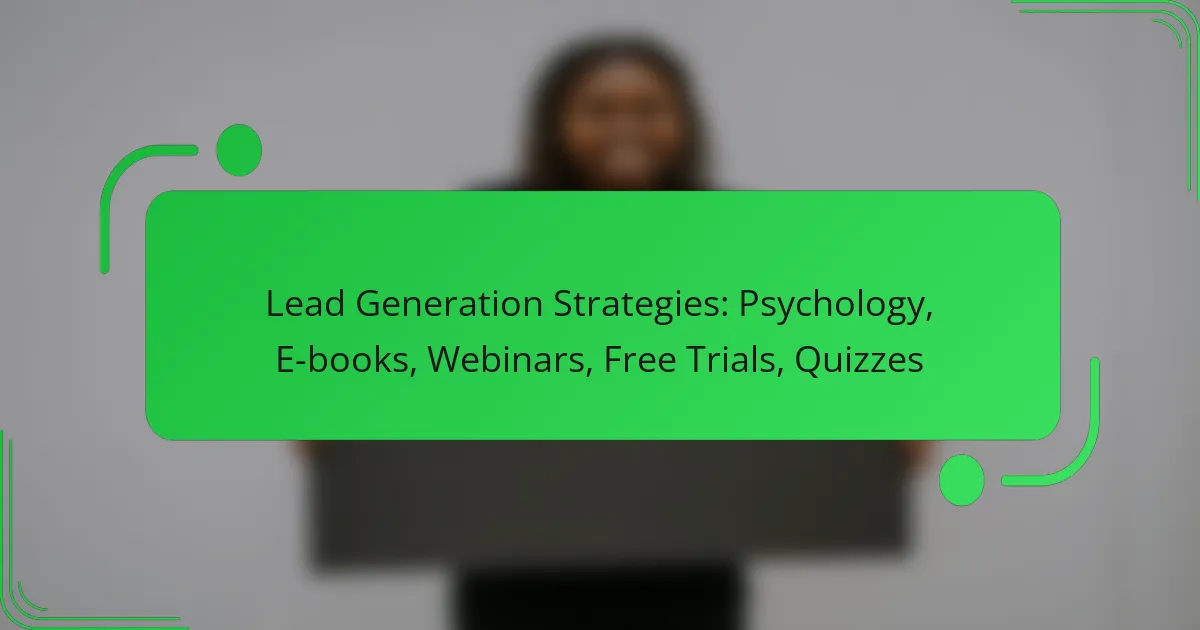Lead generation strategies such as quizzes, e-books, webinars, free trials, and case studies are essential for attracting and nurturing potential customers. These approaches not only engage users but also provide valuable insights and information, helping to build lasting relationships and convert interest into actionable leads.

What are effective lead generation strategies in Canada?
Effective lead generation strategies in Canada include interactive quizzes, informative e-books, engaging webinars, free trials, and detailed case studies. These methods not only attract potential customers but also nurture relationships by providing value and insights.
Quizzes for audience engagement
Quizzes are an interactive way to engage your audience while collecting valuable information. By creating quizzes relevant to your industry, you can encourage participation and gather data on preferences and needs.
To maximize effectiveness, ensure quizzes are fun and informative, with results that provide actionable insights. Consider using platforms like Typeform or SurveyMonkey to create and distribute your quizzes.
E-books as valuable resources
E-books serve as comprehensive resources that can educate your audience on specific topics related to your business. Offering a well-researched e-book in exchange for contact information can significantly boost your lead generation efforts.
Focus on creating e-books that address common pain points or questions in your industry. Promote them through your website and social media channels to reach a broader audience.
Webinars for real-time interaction
Webinars provide an opportunity for real-time interaction with potential leads, allowing for direct engagement and Q&A sessions. This format helps build trust and establish authority in your field.
When planning a webinar, choose a relevant topic and promote it through email and social media. Aim for a duration of 30 to 60 minutes to maintain attention, and consider offering a recording for those who cannot attend live.
Free trials to showcase products
Offering free trials allows potential customers to experience your product or service without any commitment. This strategy can effectively demonstrate value and encourage conversions.
Ensure that the trial period is long enough for users to fully explore your offering, typically ranging from a week to a month. Follow up with users during and after the trial to gather feedback and address any concerns.
Case studies to build credibility
Case studies highlight the success stories of your existing customers, showcasing how your product or service has solved their problems. This builds credibility and can influence potential leads to consider your offerings.
When creating case studies, focus on measurable results and specific challenges faced by the client. Share these on your website and through marketing materials to attract new leads by demonstrating real-world applications of your solutions.

How do quizzes enhance lead generation?
Quizzes enhance lead generation by engaging users interactively while collecting valuable data. They not only capture attention but also provide insights into user preferences, which can be used for targeted marketing efforts.
Interactive user experience
Quizzes create an engaging and interactive user experience that encourages participation. Users are more likely to complete a quiz than a traditional form, as quizzes often feel like a fun activity rather than a chore.
For example, a business might create a quiz that helps users determine their ideal product. This not only entertains but also guides potential customers towards making informed decisions, increasing the likelihood of conversion.
Data collection for targeting
Quizzes serve as effective tools for data collection, allowing businesses to gather insights about their audience. By analyzing quiz results, companies can identify trends and preferences that inform their marketing strategies.
Consider using a quiz to segment your audience based on their responses. For instance, if your quiz includes questions about user interests, you can tailor follow-up communications to specific groups, enhancing the relevance of your marketing efforts and improving conversion rates.

What are the benefits of using e-books?
E-books serve as powerful lead generation tools by providing in-depth knowledge and valuable insights to potential customers. They can attract and engage audiences, ultimately converting them into leads through informative content.
Establishing authority in the industry
Creating e-books allows businesses to showcase their expertise and establish authority within their industry. By offering well-researched and informative content, companies can position themselves as thought leaders, which builds trust with their audience.
For instance, a marketing agency might publish an e-book on the latest digital marketing trends, demonstrating their knowledge and attracting businesses seeking guidance. This not only enhances credibility but also encourages readers to turn to the agency for services.
Lead nurturing through valuable content
E-books are effective for nurturing leads by providing valuable content that addresses specific pain points. When potential customers download an e-book, they are often seeking solutions, making them more likely to engage further with the brand.
To maximize lead nurturing, businesses should ensure their e-books are relevant and actionable. Including case studies, practical tips, and clear next steps can guide readers toward making informed decisions, thereby increasing the likelihood of conversion.

How can webinars drive leads?
Webinars can effectively drive leads by providing valuable content that engages potential customers and showcases products or services. They create an interactive platform where businesses can connect with their audience, answer questions, and demonstrate expertise, ultimately converting viewers into leads.
Live demonstrations of products
Live product demonstrations during webinars allow potential customers to see offerings in action, which can significantly enhance interest and trust. By showcasing features and benefits in real-time, businesses can address specific pain points and illustrate how their products solve problems.
Consider using a structured format for demonstrations, such as highlighting key features, followed by real-world applications. This approach helps maintain audience attention and encourages questions, which can lead to deeper engagement.
Q&A sessions for audience engagement
Incorporating Q&A sessions into webinars fosters audience engagement and provides an opportunity to address specific concerns. This interactive element can help clarify doubts and build a connection with potential leads, making them feel valued and heard.
To maximize the effectiveness of Q&A sessions, prepare a list of common questions in advance and encourage attendees to submit their queries during the webinar. This proactive approach can lead to a more dynamic discussion and enhance the overall experience for participants.

What makes free trials effective?
Free trials are effective because they allow potential customers to experience a product firsthand without any financial commitment. This hands-on approach can significantly increase conversion rates by building trust and demonstrating value.
Hands-on experience with products
Offering a free trial gives users the opportunity to interact directly with your product, which can lead to a deeper understanding of its features and benefits. This experiential learning often results in higher engagement and satisfaction, as users can see how the product meets their specific needs.
For example, software companies frequently provide a 14-day free trial, allowing users to explore all functionalities. This not only showcases the product’s capabilities but also encourages users to integrate it into their daily routines, increasing the likelihood of a purchase.
Lowering barriers to entry
Free trials effectively lower barriers to entry by removing the financial risk associated with trying a new product. When potential customers can access a product without upfront costs, they are more likely to take the plunge and explore what it has to offer.
Consider a subscription service that typically charges a monthly fee. By offering a free trial, you can attract a wider audience who may have hesitated to commit financially. This strategy can lead to increased sign-ups and ultimately higher conversion rates, as users who find value in the trial are more inclined to continue with a paid subscription.

How do case studies contribute to lead generation?
Case studies are powerful tools for lead generation as they demonstrate how your product or service has effectively solved real problems for clients. By presenting detailed accounts of successful projects, they can attract potential customers looking for proven solutions.
Showcasing real-world success
Case studies highlight tangible results achieved through your offerings, showcasing real-world success stories. They often include metrics such as increased revenue, reduced costs, or improved efficiency, which can resonate with potential clients. For example, a case study might reveal how a company increased sales by 30% after implementing your software.
Including visuals like graphs or before-and-after comparisons can enhance the impact of these success stories. This not only makes the data more digestible but also reinforces the credibility of your claims.
Building trust with potential clients
By sharing detailed case studies, you build trust with potential clients who may be skeptical about your claims. When prospects see how others in similar industries have benefited from your solutions, they are more likely to feel confident in their decision to engage with your brand.
To maximize trust-building, ensure your case studies are transparent and include challenges faced during the project, along with how they were overcome. This honesty can further enhance your reputation and encourage leads to reach out for more information.

What criteria should be considered when choosing a lead generation strategy?
When selecting a lead generation strategy, consider factors such as your target audience’s preferences and your available resources, including budget. These criteria will help ensure that your chosen method effectively attracts and converts potential leads.
Target audience preferences
Understanding your target audience’s preferences is crucial for effective lead generation. Different demographics may respond better to specific strategies, such as quizzes for younger audiences or case studies for B2B professionals. Conducting surveys or analyzing past engagement can provide insights into what formats resonate most.
For instance, if your audience prefers interactive content, quizzes may yield higher engagement rates compared to static e-books. Tailoring your approach to these preferences can significantly enhance your lead generation efforts.
Resource availability and budget
Your available resources and budget will heavily influence your lead generation strategy. Some methods, like webinars, may require more investment in technology and promotion, while others, such as e-books, can be created with minimal costs. Assess your financial capacity and the time you can allocate to each strategy.
As a guideline, consider starting with low-cost options like case studies or quizzes if your budget is tight. Once you have established a successful strategy, you can gradually invest in more resource-intensive methods like webinars or free trials to expand your reach.



